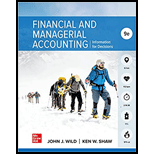
a
Concept Introduction: The allowance method records
The estimated balance of allowance for doubtful accounts assuming the company uses 4.5% of total accounts receivable as uncollectible, instead of the aging of receivable.
b
Concept Introduction: The allowance method records bad debts by matching them with estimated losses from uncollectible accounts receivable. The allowance method requires the estimation of total bad debt expected from sales during the period. This method is better than direct write-off because it records estimated bad debts expense for the period of sales and it reports the estimated amount of cash collected from accounts receivable in the balance sheet.
The year-end
c
Concept Introduction: The allowance method records bad debts by matching them with estimated losses from uncollectible accounts receivable. The allowance method requires the estimation of total bad debt expected from sales during the period. This method is better than direct write-off because it records estimated bad debts expense for the period of sales and it reports the estimated amount of cash collected from accounts receivable in the balance sheet.
The year-end adjustment entry to record bad debts assuming allowance for a doubtful account has an unadjusted balance of $1,000 debit.
Want to see the full answer?
Check out a sample textbook solution
Chapter 7 Solutions
FINANCIAL+MGRL.ACCT.(LL)-W/CODE>CUSTOM<
- Which accounting principle requires that expenses be matched with revenues in the period in which they are incurred to produce those revenues? A) Going Concern Principle B) Matching Principle C) Consistency Principle D) Conservatism Principle MCQarrow_forwardSolve this questions?arrow_forwardWhich account is not closed at the end of an accounting period? Consider typical accounts maintained in the general ledger. (A) Sales (B) Wages Expense (C) Capital (D) Rent Revenue MCQarrow_forward
- what is the gross profit margin? please fast give me answerarrow_forwardHarlan Corp. produced 2,000 units during the month. • Direct materials: $45 per unit • Direct labor: $38 per unit • Variable manufacturing overhead: $12 per unit • Fixed manufacturing overhead: $60,000 • No beginning or ending inventory What is the absorption costing unit product cost?arrow_forwardI need guidance with this financial accounting problem using the right financial principles.arrow_forward
 Financial AccountingAccountingISBN:9781305088436Author:Carl Warren, Jim Reeve, Jonathan DuchacPublisher:Cengage Learning
Financial AccountingAccountingISBN:9781305088436Author:Carl Warren, Jim Reeve, Jonathan DuchacPublisher:Cengage Learning Financial And Managerial AccountingAccountingISBN:9781337902663Author:WARREN, Carl S.Publisher:Cengage Learning,
Financial And Managerial AccountingAccountingISBN:9781337902663Author:WARREN, Carl S.Publisher:Cengage Learning, Financial AccountingAccountingISBN:9781337272124Author:Carl Warren, James M. Reeve, Jonathan DuchacPublisher:Cengage Learning
Financial AccountingAccountingISBN:9781337272124Author:Carl Warren, James M. Reeve, Jonathan DuchacPublisher:Cengage Learning- Principles of Accounting Volume 1AccountingISBN:9781947172685Author:OpenStaxPublisher:OpenStax College
 College Accounting, Chapters 1-27AccountingISBN:9781337794756Author:HEINTZ, James A.Publisher:Cengage Learning,
College Accounting, Chapters 1-27AccountingISBN:9781337794756Author:HEINTZ, James A.Publisher:Cengage Learning,





